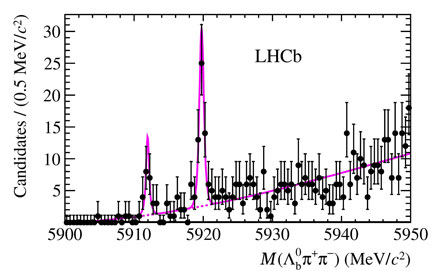- A timely news piece which describes the why, what, where and when of a result or event, and its implications
- Based on something new: research, upcoming collaborations and events for example
- Written for one of the core website's key audiences: CERN people, scientists, students and educators or the general public
- No local trivia (local news should be published on Project Voisins, the website for CERN's neighbours)
- May include comment (quotes) directly from sources. Ideally, quotes should not be copied from press releases, and “Always make two phone calls”.
- Illustrated with a relevant image, preferably unique to CERN
NOTE: For in-depth news coverage, updates can exceptionally run up to 800 words. This must be decided in advance with the editor when the story is being commissioned.
[Update written for the general public]
LHCb discovers new excited states for the Λb beauty particle
Though the Standard Model of particle physics predicts the existence of these new states, this is the first time they have been confirmed in an experiment
 The new excited states show clear signals at masses of 5912 MeV/c2
The new excited states show clear signals at masses of 5912 MeV/c2and 5920 MeV/c2 (Image: LHCb collaboration)
The Large Hadron Collider beauty (LHCb) experiment at CERN today announced that it has observed two new excited states of the Λb beauty baryon. The two new states, predicted by the Standard Model of particle phyics, have never before been seen in an experiment.
Baryons are subatomic particles whose mass is equal to or greater than that of a proton. Like protons and neutrons, the Λb beauty baryon is composed of three quarks. In Λb these are up, down and beauty quarks. LHCb physicists found the signals for the Λb particles in a sample of about 60 trillion proton—proton collisions which were delivered by the LHC operating at a centre-of-mass energy of 7 TeV in 2011. They measured the masses of the new excited states as 5912 MeV/c2 and 5920 MeV/c2 respectively - over five times greater than the mass of a proton or neutron.
The result adds to a growing list of discoveries at CERN in recent months. Last month the Compact Muon Solenoid (CMS) experiment observed a new excited state for the Ξb beauty baryon, and back in December 2011 ATLAS detected a new "quarkonium state" containing a beauty quark bound with its antiquark.